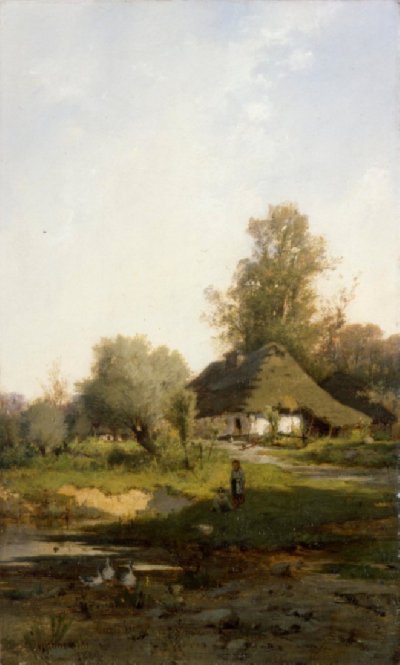Roman Kochanowski after leaving the workshop of W. Łuszczkiewicz and H. Grabiński of the Krakow School of Fine Arts, studied in the years 1875 to 1880 together with F. Krudowski in the workshop of Ch. Griepenkerl in Vienna. Later, they parted ways. Krudowski after receiving the Rome Prize in 1880 switched to religious and mythological painting, an example of which was probably his now lost work of Psyche, located in the lobby before the war. Kochanowski while relocating to the landscape faculty of E. Lichtenfels, where he won the gold medal, devoted himself to landscape painting. Since settling permanently in Munich in 1881, old views of the Vistula and the Cracow gave way to the Bavarian landscapes. Award-winning paintings of Kochanowski, were bought, among others, by Emperor Franciszek Józef in 1888 and 1889. Kochanowski was actively participating in the life of Polish artist colony in Munich, where he became friends with P. Stachiewicz (1858-1938). The latter, together with St. Tondos (1854-1917) enabled him to work with Krakow's World magazine, which he illustrated throughout its existence (1887-1895). It is no accident thus in the pre-war gallery, work of these artists were adjacent to each other. They were Sienna Street in Krakow of St.Tondos [watercolor on paper, 58 x 41.5, Ref. P. D. Tondos, inv. MNP FR 372] and Queen of P. Stachiewicz of 1910 [crayon on paper, 40 x 54, Ref. P. D. P. Stachiewicz, inv. MNP FR 298].
Of the three works of Roman Kochanowski (1857-1945), hanging in the hall before the war, until today preserved only very Munich like landscape In the countryside, from 1880. As many of his early works it shows Krakow suburb landscape with rural shack and small staffage over which extends the vastness of the blue sky. The whole is maintained in subdued colors, of so-called Munich sauces, affecting its lyrical interpretation.
[dr E.Leszczyńska]
